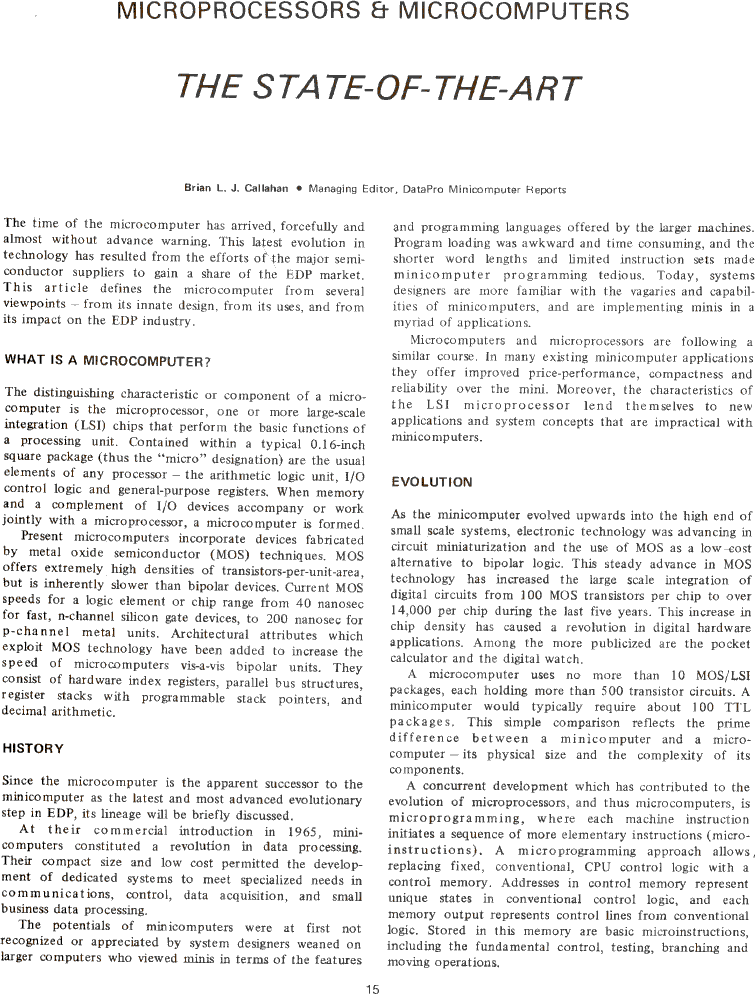by Brian L. J. Callahan

MICROPROCESSORS & MICROCOMPUTERS THE STATE-OF-THE-ART Brian L. J. Callahan . Managing Editor, DataPro Minicomputer Reports The time of the microcomputer has arrived, forcefully and almost without advance warning. This latest evolution in technology has resulted from the efforts of the ajor semiconductor suppliers to gain a share of the EDP market. This article defines the microcomputer from several viewpoints - from its innate design, from its uses, and from its impact on the EDP industry. *** WHAT IS A MICROCOMPUTER? The distinguishing characteristic or component of a microcomputer is the microprocessor, one or more large-scale integration (LSI) chips that perform the basic functions of a processing unit. Contained within a typical 0.16-inch square package (thus the "micro" designation) are the usual elements of any processor -the arithmetic logic unit, I/O control logic and general-purpose registers. When memory and a complement of I/O devices accompany or work jointly with a microprocessor, a microcomputer is formed. Present microcomputers incorporate devices fabricated by metal oxide semiconductor (MOS) techniques. MOS offers extremely high densities of transistors-per-unit-area, but is inherently slower than bipolar devices. Current MOS speeds for a logic element or chip range from 40 nanosec for fast, n-channel silicon gate devices, to 200 nanosec for p-channel metal units. Architectural attributes which exploit MOS technology have been added to increase the speed of microcomputers vis-a-vis bipolar units. They consist of hardware index registers, parallel bus structures, register stacks with programmable stack pointers, and decimal arithmetic. *** HISTORY Since the microcomputer is the apparent successor to the minicomputer as the latest and most advanced evolutionary step in EDP, its lineage will be briefly discussed. At their commercial introduction in 1965, minicomputers constituted a revolution in data processing. Their compact size and low cost permitted the development of dedicated systems to meet specialized needs in communications, control, data acquisition, and small business data processing. The potentials of minicomputers were at first not recognized or appreciated by system designers weaned on larger computers who viewed minis in terms of the features and programming languages offered by the larger machines. Program loading was awkward and time consuming, and the shorter word lengths and limited instruction sets made minicomputer programming tedious. Today, systems designers are more familiar with the vagaries and capabilities of minicomputers, and are implementing minis in a myriad of applications. Microcomputers and microprocessors are following a similar course. ln many existing minicomputer applications they offer improved price-performance, compactness and reliability over the mini. Moreover, the characteristics of the LSI microprocessor lend themselves to new applications and system concepts that are impractical with minicomputers. *** EVOLUTION As the minicomputer evolved upwards into the high end of small scale systems, electronic technology was advancing in circuit miniaturization and the use of MOS as a low cost altemative to bipolar logic. This steady advance in MOS technology has increased the large scale integration of digital circuits from 100 MOS transistors per chip to over 14,000 per chip during the last five years. This increase in chip density has caused a revolution in digital hardware applications. Among the more publicized are the pocket calculator and the digital watch. A microcomputer uses no more than 10 MOS/LSI packages, each holding more than 500 transistor circuits. A minicomputer would typically require about 100 TTL packages. This simple comparison reflects the prime difference between a minicomputer and a microcomputerits physical size and the complexity of its components. A concurrent development which has contributed to the evolution of microprocessors, and thus microcomputers, is microprogramming, where each machine instruction initiates a sequence of more elementary instructions (microinstructions). A microprogramming approach allows, replacing fixed, conventional, CPU control logic with a control memory. Addresses in control memory represent unique states in conventional control logic, and each memory output represents control lines from conventional logic. Stored in this memory are basic microinstructions, including the fundamental control, testing, branching and moving operations.

